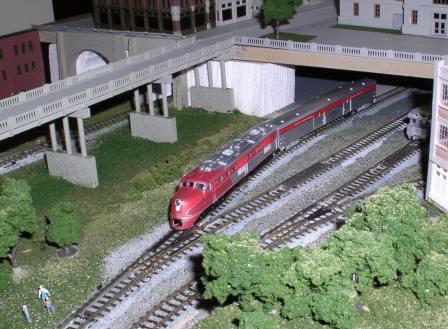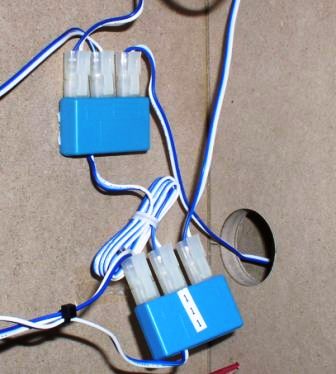Good DCC practice means good planning for the electrical needs of the railroad. Here, we talk about the power needs of the Texas & Southwestern.

Anticipating Power Consumption The core of the Texas & Southwestern's DCC control system will be the DCS50 Zephyr, which is very appropriate for a small railroad. Zephyr has 10 "slots", memory locations in the command station each holding an active decoder address. Rated at 2.5 Amps, the Zephyr should also be enough to handle the power needs of the railroad, but if more power is needed, then T&SW can easily be expanded with an additional booster and power supply. The power needs of the T&SW were estimated in this way:
- 5 locomotives - It was assumed that the railroad would have five locomotives present at any given time
- 4 passenger cars illuminated with LED's - It was assumed that there would be four passenger cars, more than enough for a small railroad.
- Kato Unitrack turnouts - The Texas & Southwestern has twelve Unitrack turnouts, but only one operates at any given time.
The Basis of the Calculation The T&SW's power needs were estimated in this way:
- Locomotive Power - A typical N-Scale locomotive consumes 300 MA when in operation. When idle, the locomotive decoder still draws 5 MA and the headlights draw 50MA if they are conventional light bulbs or 15MA if they are LED's. So, we assumed that each locomotive would draw 350MA
- Passenger Car Lighting - It was assumed that each car would draw 15MA, using LED internal lighting kits
- Turnouts - It was assumed that each turnout would draw 200MA when in operation.
- DCC Devices - The T&SW has twelve turnouts, each controlled by a DS51K1. Each DS51K1 was assumed to draw 5MA when the railroad is in operation. The railroad also includes an AR1 Auto Reversing Unit, which is assumed to draw 30MA when the railroad is in operation.
The Calculation
- Locomotives - 5 locomotives at 350MA each = 1750MA
- Passenger Cars - 4 passenger cars at 15MA each = 60MA
- Turnouts - Only one turnout operates at any given time, so 200MA
- DCC Devices - 12 DS51K1's at 5MA each, one AR1 at 30MA; 12 x 5 = 60MA, plus 30MA = 90MA
1750MA 60MA 200MA 90MA 2100MA Total The total power consumption of the railroad is estimated to be 2100MA, or 2.1 Amps. The total power capacity of the Zephyr is 2.5 Amps, with the Zephyr drawing its own power needs from the same PS315 power supply. So, by estimation, the Zephyr and its power supply should be sufficient for powering the Texas & Southwestern. It should be noted that the DCS50's 2.5 Ampere rating is "peak", meaning that the Zephyr can handle a 2.5 Amp load for a period of time, but it should not be operated at 2.5 Amps continuously because of heat build up in the unit. If your power consumption is continuously around the rated power of the booster, you should consider dividing your railroad up into power districts and adding additional boosters.
Things Change At the same time, things change and estimates are just that, estimates. When the railroad was built, it was anticipated that it might be necessary to add a booster & power supply and train detection for signaling at a later date. So, when the tracks were placed, the railroad was divided up into smaller isolated segments, and all were joined together by using Kato 24-827 3-Way Extension Cords.

If, at a later date, the layout owner wanted to add train detection for signaling, it is a minor matter of disconnecting the various segments and the reconnecting them to BD4s or a BDL168. Likewise, if the railroad's power needs continue to grow, it is also easy to disconnect the track connections and then reconnect them as needed.
Many thanks to Mr. Riley O'Connor for sharing the Texas & Southwestern with us.